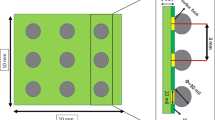Abstract
One of major reasons for the failure of solder joints is thermal fatigue. Also, the failure of solder joints under thermal fatigue loading is influenced by varying boundary conditions such as the material of the solder joint, the materials of substrates(related to the difference in CTE), the height of solder, the distance of the solder joint from the neutral point (DNP), the temperature variation and the dwell time. In this paper, first, the experimental results obtained from thermal fatigue test are compared to the outcomes from theoretical thermal fatigue life equations. Second, the effects of varying boundary conditions on the failure probability of the solder joint are studied by using probabilistic methods such as the first order reliability method (FORM) and Monte Carlo simulation (MCS).
Similar content being viewed by others
References
R. Darveaux, J. Heckman, A. Syed and A. Mawer, Solder joint fatigue life of fine pitch BGAs-impact of design and material choices, Microelectronics Reliability 40 (2000) 1117–1127.
J. H. Lau, Solder Joint Reliability Theory and Application, Van Nostrand Reinhold, (1991).
A. Haldar, S. Mahadevan, Probability, Reliability, and Statistical Methods in Engineering Design, John Wiley & Sons, (2000).
O. S. Lee, S. S. Choi and D. H. Kim, Effect of varying boundary conditions on the buried pipelines, Solid State Phenomena, 110 (2006) 221–230.
O. S. Lee and D. H. Kim, Reliability of buried pipeline using FORM and Monte Carlo simulation, Key Engineering Materials, 321–323 (2006) 1543–1547.
A. Guedon-Gracia, E. Woirgard and C. Zardini, Correlation between experimental results and FE simulations to evaluate lead-free BGA assembly reliability, Microelectronics Reliability 45 (2005) 1652–1657.
J. E. Ryu, T. K. Hwang and S. B. Lee, The influence of microstructure development on the thermal fatigue behaviors of BGA solder joint, unpublished.
O. S. Lee, M. J. Hur, J. S. Hawong, N. H. Myoung and D. H. Kim, Reliability estimation of solder joint by using the failure probability, Key Engineering Materials, 326–328 (2006) 621–624.
O. S. Lee and D. H. Kim, The reliability estimation of pipeline using FORM, SORM and Monte Carlo simulation with FAD, Journal of Mechanical Science and Technology, 20(12) (2006) 2124–2135.
Author information
Authors and Affiliations
Corresponding author
Rights and permissions
About this article
Cite this article
Lee, O.S., Park, Y.C. & Kim, D.H. Reliability estimation of solder joints under thermal fatigue with varying parameters by using FORM and MCS. J Mech Sci Technol 22, 683–688 (2008). https://doi.org/10.1007/s12206-008-0117-2
Received:
Revised:
Accepted:
Published:
Issue Date:
DOI: https://doi.org/10.1007/s12206-008-0117-2




